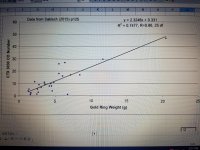LawrencetheMDer
Hero Member
- Feb 22, 2014
- 985
- 2,400
- 🏆 Honorable Mentions:
- 2
- Detector(s) used
-
Minelab Manticore, Minelab CTX3030 w 11" and 17" DD coils,
Minelab Excalibur II w 10" coil, Equinox 800 (4) w 11" and 15" coils,
Troy Shadow x2 w 7" coil, Pointers; Garrett Carrot, Pro Find 35,
- Primary Interest:
- Beach & Shallow Water Hunting
In several recent studies, I have shown that the CTX 3030 CO number is heavily dependent on the weight of the target; as target weight increases so does the CO number. This positive relationship between target weight and CO number holds for both lead (fishing weights) and aluminum foil. In the present study, I looked at the relationship between gold ring weight and CTX 3030 CO number.
I gathered and analyzed data about gold (10K and 14K) ring weight and CO numbers from displayed ring data shown in Andy Sabisch's CTX 3030 handbook (p125). A total of 27 rings were used in the analysis, the results of which are shown in the Figure.

The data show a very high correlation between gold ring weight and CO number (R=0.86), indicating the two are closely related. The figure shows a strong straight line relation between gold ring weight and CTX 3030 CO number; as gold ring weight increased from 1.3g to 20.5g the CO number increased from 1 to 46.5. From a MD hunting point of view, it is important to note that the vast majority (25/27) of gold rings fell under a CO of 30, simply because their weight was under 9g.
I recently came across, on FindMall, a post by Steve (sgoss66) with the following FE:CO numbers for US gold coins:
One dollar at 1.67g (Type 1) 12:11
One dollar at 1.67g (Type 3) 12:09
$2.50 at 4.2 is listed as 12:22
$5.00 at 8.4g is listed as 12:30
$10.00 at 16.7g is listed at 12:37-38
It is obvious from Steve's data (I added weight data) that as denomination and weight increases so does the CO number. The data from gold coins goes well with the other accumulated evidence in support of the observation that CO number most closely reflects the weight of the target. [Target size or surface area and CO number is dealt with in another post, in prep.]
The present data on gold rings and US gold coins further support the observation that CO number on the CTX 3030 is primarily driven by target weight. I have demonstrated that this general rule applies to lead, aluminum foil, gold rings and gold coins. Based on this evidence, the CO range from 1-50 on the CTX 3030 can be considered a weight scale to the first approximation, with light weight objects falling at the low end and heavier weight objects falling on the high end of the CTX 3030 CO axis.
Given that the CO axis on the CTX 3030 is weight dependent, one conclusion is that valuable gold rings and jewelry can fall anywhere along the CO axis including regions often believed to be predominated by pull-tabs and push-tabs (12:15-23); be cautious what you screen or filter out...it might be gold.
I gathered and analyzed data about gold (10K and 14K) ring weight and CO numbers from displayed ring data shown in Andy Sabisch's CTX 3030 handbook (p125). A total of 27 rings were used in the analysis, the results of which are shown in the Figure.

The data show a very high correlation between gold ring weight and CO number (R=0.86), indicating the two are closely related. The figure shows a strong straight line relation between gold ring weight and CTX 3030 CO number; as gold ring weight increased from 1.3g to 20.5g the CO number increased from 1 to 46.5. From a MD hunting point of view, it is important to note that the vast majority (25/27) of gold rings fell under a CO of 30, simply because their weight was under 9g.
I recently came across, on FindMall, a post by Steve (sgoss66) with the following FE:CO numbers for US gold coins:
One dollar at 1.67g (Type 1) 12:11
One dollar at 1.67g (Type 3) 12:09
$2.50 at 4.2 is listed as 12:22
$5.00 at 8.4g is listed as 12:30
$10.00 at 16.7g is listed at 12:37-38
It is obvious from Steve's data (I added weight data) that as denomination and weight increases so does the CO number. The data from gold coins goes well with the other accumulated evidence in support of the observation that CO number most closely reflects the weight of the target. [Target size or surface area and CO number is dealt with in another post, in prep.]
The present data on gold rings and US gold coins further support the observation that CO number on the CTX 3030 is primarily driven by target weight. I have demonstrated that this general rule applies to lead, aluminum foil, gold rings and gold coins. Based on this evidence, the CO range from 1-50 on the CTX 3030 can be considered a weight scale to the first approximation, with light weight objects falling at the low end and heavier weight objects falling on the high end of the CTX 3030 CO axis.
Given that the CO axis on the CTX 3030 is weight dependent, one conclusion is that valuable gold rings and jewelry can fall anywhere along the CO axis including regions often believed to be predominated by pull-tabs and push-tabs (12:15-23); be cautious what you screen or filter out...it might be gold.
Upvote
0


